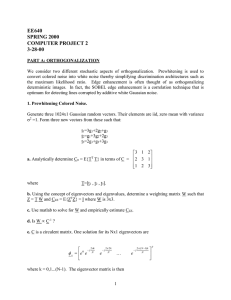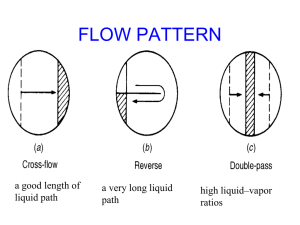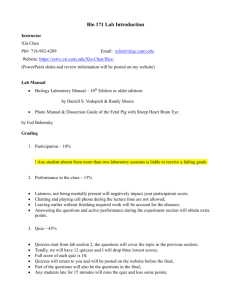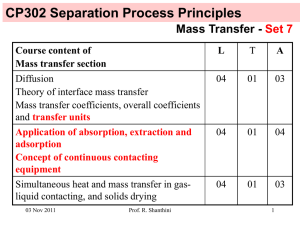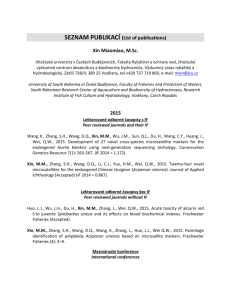Crystallization
advertisement
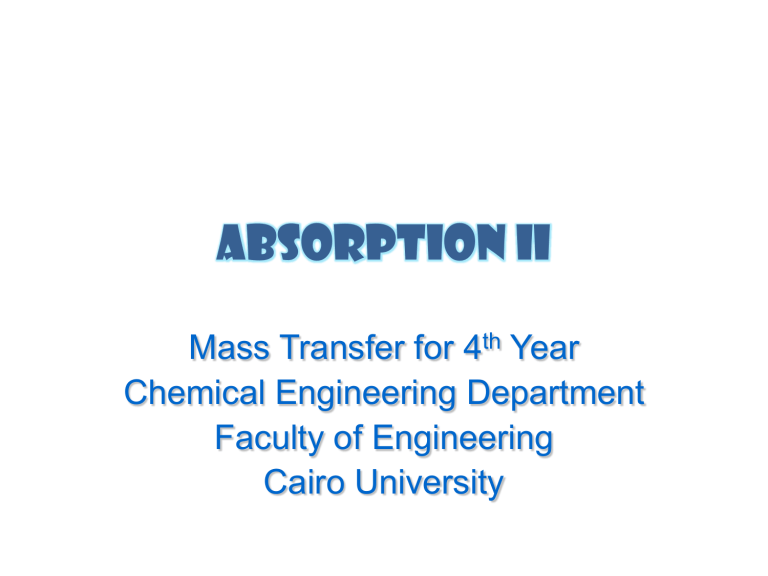
Absorption II Mass Transfer for 4th Year Chemical Engineering Department Faculty of Engineering Cairo University Today’s Agenda • Adiabatic Absorption • Stripping • Multi-component Absorbtion Adiabatic Absorption Absorption is an exothermic process. If absorber is not cooled, the temperature of the liquid will increase leading to changing the equilibrium relation used. Remember: y=mx & For the same system m=f(T,P) Our task now is to get an equilibrium curve that includes the changes in temperature occurring. Adiabatic Absorption We will assume that the heat liberated by absorption will be gained ONLY by liquid. Overall M.B.: G’(Yin-Yout)=L’(Xout-Xin) E.B. on loop: Heat liberated by absorption =heat gained by liquid Lin Xin Tin Tout1 Xout1 Tout2 Xout2 Tout3 Xout3 Tout4 Xout4 Adiabatic Absorption E.B. on loop: Heat liberated by absorption =heat gained by liquid L’(Xout(i)-Xin)×qabs=L’×CPL(Tout(i)-Tin) X outi Xin CPL q T outi Tin So we can get Xout(i) by knowing Tout(i) Lin Xin Tin Tout1 Xout1 Tout2 Xout2 Tout3 Xout3 Tout4 Xout4 Problem 3: 470 lb/hr of an air-NH3 mixture containing 5% by weight NH3 are scrubbed with water at 70oC in an adiabatic tower in order to remove 95% of the NH3 present. The heat of solution of NH3 in water is 300 BTU/lb, and the isothermal equilibrium data at different temperatures may be approximated into straight line as below: Temperature, oC 70 75 80 85 Y/X 1/6 1/3 2/3 1 Where Y and X are mass ratios Calculate: • L’min. • Required number of actual plates if stage efficiency is 35% using 1.5 L’min. • The number of theoretical stages using the same liquid flow rate at constant temperature of 70oC and Yout Givens: G= 470 lb/hr a=0.95 q=300 BTU/lb CpW=1 BTU/lb.R yin=0.05 xin=0 G’=470*(1-0.05)=446.5 lb/hr Yin=0.05/(1-0.05)=0.0526 Xin=0 Yout=0.0526*(1-0.95)=0.00263 1 0,9 0,8 0,7 0,6 Y 0,5 0,4 0,3 0,2 0,1 0 0 0,1 0,2 0,3 0,4 0,5 0,6 X 0,7 0,8 0,9 1 1,1 1 0,9 0,8 0,7 0,6 Y 0,5 0,4 0,3 0,2 0,1 0 0 0,1 0,2 0,3 0,4 0,5 0,6 X 0,7 0,8 0,9 1 1,1 1 0,9 0,8 0,7 0,6 Y 0,5 0,4 0,3 0,2 0,1 0 0 0,1 0,2 0,3 0,4 0,5 0,6 X 0,7 0,8 0,9 1 1,1 1 0,9 0,8 0,7 0,6 Y 0,5 0,4 0,3 0,2 0,1 0 0 0,1 0,2 0,3 0,4 0,5 0,6 X 0,7 0,8 0,9 1 1,1 To get the points on the curves to get the new equilibrium curve, use the relation: X outi Xin CPL T outi q Tin Tin=70oC=158 oF X outi 1 0 Touti 158 300 Tout Tout (oF) Xout 70 158 0 75 167 0.03 80 176 0.06 85 185 0.09 0,1 0,09 0,08 0,07 0,06 Y 0,05 0,04 0,03 0,02 0,01 0 0 0,01 0,02 0,03 0,04 0,05 X 0,06 0,07 0,08 0,09 0,1 0,1 0,09 0,08 0,07 0,06 Y 0,05 0,04 0,03 0,02 0,01 0 0 0,01 0,02 0,03 0,04 0,05 X 0,06 0,07 0,08 0,09 0,1 0,1 0,09 0,08 0,07 0,06 Y 0,05 0,04 0,03 0,02 0,01 0 0 0,01 0,02 0,03 0,04 0,05 X 0,06 0,07 0,08 0,09 0,1 Operating line: G’=446.5 lb/hr Yin=0.0526 Xin=0 Yout=0.00263 0,1 0,09 0,08 0,07 0,06 Y 0,05 0,04 0,03 0,02 0,01 0 0 0,01 0,02 0,03 0,04 0,05 X 0,06 0,07 0,08 0,09 0,1 0,1 0,09 0,08 0,07 0,06 Y 0,05 0,04 0,03 0,02 0,01 0 0 0,01 0,02 0,03 0,04 0,05 X 0,06 0,07 0,08 0,09 0,1 0,1 0,09 0,08 0,07 0,06 Y 0,05 0,04 0,03 0,02 0,01 0 0 0,01 0,02 0,03 0,04 0,05 X 0,06 0,07 0,08 0,09 0,1 iL’min/G’ =0.735 L’min=0.735*446.5=328.1 lb/hr iiL’op=1.5L’min=492.16 lb/hr L’op/G’=1.1 Xout=0.0453 0,1 0,09 0,08 0,07 0,06 Y 0,05 0,04 0,03 0,02 0,01 0 0 0,01 0,02 0,03 0,04 0,05 X 0,06 0,07 0,08 0,09 0,1 0,1 0,09 0,08 0,07 0,06 Y 0,05 0,04 0,03 0,02 0,01 0 0 0,01 0,02 0,03 0,04 0,05 X 0,06 0,07 0,08 0,09 0,1 0,1 0,09 0,08 0,07 0,06 Y 0,05 0,04 0,03 0,02 0,01 0 0 0,01 0,02 0,03 0,04 0,05 X 0,06 0,07 0,08 0,09 0,1 NAS=7 iiiL’/G’=1.1 Yin=0.0526 Xin=0 Yout=0.00263 0,1 0,09 0,08 0,07 0,06 Y 0,05 0,04 0,03 0,02 0,01 0 0 0,01 0,02 0,03 0,04 0,05 X 0,06 0,07 0,08 0,09 0,1 iiiNTS=1.6 STRIPPING STRIPPING The process opposite to absorption, the solvent is stripped to be recovered. The operating line equation will not change, but it will be located BELOW the equilibrium curve. The main objective will no longer be Yout, it will be Xout, so Recovery (a) will be used as follows: Xout=Xin(1-a) Same steps will be done: getting G’min, calculating G’op and determining the number of ideal stages. GETTING Gmin 0,12 0,11 0,1 0,09 Y 0,08 0,07 0,06 Yout 0,05 0,04 0,03 0,02 0,01 Yin Xin 0 0 XOut0,01 0,02 0,03 0,04 0,05 0,06 0,07 0,08 X 0,09 0,1 0,11 0,12 GETTING Gmin 0,12 0,11 0,1 0,09 Y 0,08 0,07 0,06 Yout 0,05 0,04 0,03 0,02 0,01 Yin Xin 0 0 XOut0,01 0,02 0,03 0,04 0,05 0,06 0,07 0,08 X 0,09 0,1 0,11 0,12 GETTING Gmin 0,12 0,11 0,1 0,09 Y 0,08 0,07 0,06 Yout 0,05 0,04 0,03 0,02 0,01 Yin Xin 0 0 XOut0,01 0,02 0,03 0,04 0,05 0,06 0,07 0,08 X 0,09 0,1 0,11 0,12 GETTING Gmin 0,12 0,11 0,1 0,09 Y 0,08 0,07 0,06 Yout 0,05 0,04 0,03 0,02 0,01 Yin Xin XOut 0 0 0,01 0,02 0,03 0,04 0,05 0,06 0,07 0,08 X 0,09 0,1 0,11 0,12 Operating Line 0,12 0,11 0,1 0,09 Y 0,08 0,07 0,06 Yout 0,05 0,04 0,03 0,02 0,01 Yin Xin 0 0 XOut0,01 0,02 0,03 0,04 0,05 0,06 0,07 0,08 X 0,09 0,1 0,11 0,12 Problem 5: As a result of an absorption process, there is a solution which must be stripped of absorbed solute. 500 Kmole/hr of this solution of benzene in a non-volatile oil containing 0.1 mole fraction benzene. The solution will be preheated to 250oF and will be stripped at 1 atm absolute with superheated steam at 250oF. The liquid effluent from the stripper is to contain no more than 0.005 mole fraction benzene. Assume isothermal operation and Raoult’s law is applied. Vapour pressure of benzene at 250oF is 2400 mmHg. Determine the minimum steam rate, the number of ideal trays required for 1.25 times the minimum rate. Problem 5: xin=0.1 Xin=0.1/(1-0.1)=0.111 L= 500 Kmole/hr L’=500*(1-0.1)=450 Kmole/hr T=250oF P=1 atm=760 mmHg xout=0.005 Xout=0.005/(1-0.005)=0.00503 yin=0 Yin=0 Isothermal operation and Raoult’s law is applied. PoB = 2400 mmHg. m=2400/760=3.16 3.16X Y y=3.16x 1 2.16X G’op=1.25 G’min 3.16 X Y 1 2.16X X 0 0.02 0.04 0.06 0.08 0.1 0.12 Y 0 0.066 0.138 0.218 0.306 0.403 0.512 0,6 0,5 0,4 Y 0,3 0,2 0,1 0 0 0,01 0,02 0,03 0,04 0,05 0,06 0,07 X 0,08 0,09 0,1 0,11 0,12 0,13 0,55 0,5 0,45 0,4 0,35 0,3 Y 0,25 0,2 0,15 0,1 0,05 0 0 0,01 0,02 0,03 0,04 0,05 0,06 0,07 X 0,08 0,09 0,1 0,11 0,12 0,13 iL’/G’min=3.96 G’min=450/3.96=113.66 Kmol/hr iiG’op=1.25 G’min=142.08 Kmol/hr L’/G’op=3.17 0,55 0,5 0,45 0,4 0,35 0,3 Y 0,25 0,2 0,15 0,1 0,05 0 0 0,01 0,02 0,03 0,04 0,05 0,06 0,07 X 0,08 0,09 0,1 0,11 0,12 0,13 iL’/G’min=3.96 G’min=450/3.96=113.66 Kmol/hr iiG’op=1.25 G’min=142.08 Kmol/hr L’/G’op=3.17 NTS=10.5 Multi-Component Absorption - This is the general case, and the most abundant. - The solvent will have the ability to dissolve more than one component from the gas stream. - Different recovery percentages will be achieved for each component. -Here is the only case where we can work by mole fractions not ratios. Design Steps Information available: 1- L/G or n 2- Feed gas composition (purity) yinA , yinB , yinC , .. 3- Available solvent purity xinA , xinB , xinC ,….. 4- Equilibrium of each component with solvent. 5- Key component Recovery (aA) youtA yinA 1 aA Usually he wants you to calculate the recovery of other components. Multi-Component Absorption There is two methods for solution Graphical method Analytical Kremser method (to use it equilibrium should be straight line) Graphical method Analytical method:
